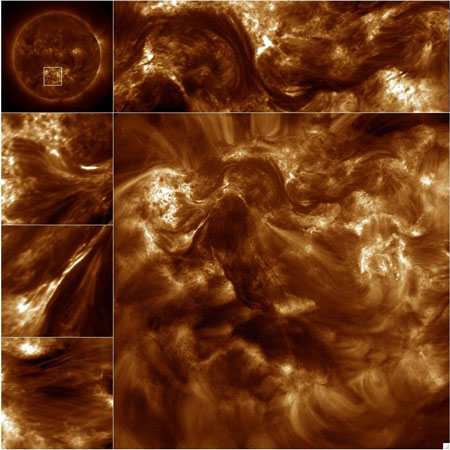| Jan 23, 2013 |
Sounding rocket flight provides important clues to coronal heating, and points the way to future solar missions
|
|
(Nanowerk News) A NASA sounding rocket flight in 2012 captured five minutes of the highest-resolution images ever taken of the Sun's million-degree outer atmosphere, the corona. The new images have provided tantalizing hints of another mechanism that likely contributes to the heating of the solar corona. In a paper published today in the journal Nature ("Energy release in the solar corona from spatially resolved magnetic braids"), researchers from multiple government and private institutions – including the Solar & Astrophysics Lab at the Lockheed Martin Advanced Technology Center (ATC) in Palo Alto – have analyzed the data and identified a likely source of heat that replenishes the corona. The clarity of the new images will also help scientists better predict when violent solar eruptions threaten Earth’s space environment.
|
 |
| The Hi-resolution Coronal Imager full resolution image shown here is from the solar active region outlined in the AIA image (upper left). Several partial frame images are shown including a potion of a filament channel (upper center/right), the braided ensemble (left, second from top), an example of magnetic recognition and flaring (left, third from top), and fine stranded loops (left, bottom). These Hi-C images are at a resolution of 0.2" or 90 miles. This resolution is the equivalent of resolving a dime from 10 miles away. (Image: NASA)
|
|
On July 12, 2012, NASA scientists launched a solar telescope called Hi-C, for High Resolution Coronal Imager, into space, aboard a Black Brant sounding rocket from the White Sands Missile Range in New Mexico. The mission took just 620 seconds for its flight, spending about half of that time high enough that Earth's atmosphere would not block ultraviolet rays from the Sun. By looking at a specific range of UV light, HI-C scientists were able to observe fundamental structures on the Sun, as narrow as 150 miles across.
|
|
The visible surface of the Sun, called the photosphere, is relatively cool, at 6,000 degrees C, but is enveloped by the much hotter gas of the corona. One of the most enduring mysteries in solar physics is why the Sun’s corona is millions of degrees hotter than its surface. During the past few decades, a wide variety of theoretical models to explain this enigma have been proposed, but the lack of detailed observations of the fundamental heating process has left the question still open.
|
|
Because of its high temperatures, all matter in the Sun takes the form of gas and plasma. The gases below the solar surface bubble like a boiling soup, dragging magnetic field around. Any field in the solar atmosphere is anchored in these random motions, so that the atmospheric field loops become twisted and entwined into ‘braids.’ As the braids become more tightly wound like a twisted rubber band, they store enormous amounts of heat. Eventually, as the braids become severely distorted by the twisting, they snap and unwind, dissipating their heat into the solar corona. Large energy releases are known as solar flares. A multitude of smaller such events was speculated to occur to sustain the background coronal glow.
|
|
The Atmospheric Imaging Assembly (AIA) on NASA’s Solar Dynamics Observatory provided complimentary full-Sun images before during and after the Hi-C observations. The AIA images provided the essential context in analyzing the Hi-C data. In fact, it was AIA that captured a C-class solar flare centered on the braided magnetic field loops that Hi-C had imaged, about three minutes after the Hi-C flight had concluded. This provided conclusive proof of the energy release into the corona.
|
|
"The Hi-C observations zoom in on what happens within the global view of the Sun that is seen with NASA's Solar Dynamics Observatory. The combination of the big-picture view with the unprecedented Hi-C images shows us processes in action that we could only theorize about until now, processes that are fundamental to the workings of the solar atmosphere and all of space weather, and that apply at any other Sun-like star where we would never be able to see them in action,” said Dr. Karel Schrijver of the Solar & Astrophysics Laboratory at the ATC. “The Hi-C images demonstrate that we now have the technology to make the next leap in understanding the Sun's violent magnetism."
|
|
“It is clear from the Hi-C observations that the closer we look at the Sun, the better we understand how it works,” said co-author of the Nature paper Dr. Bart De Pontieu of the ATC, and lead scientist on NASA’s upcoming Interface Region Imaging Spectrograph (IRIS) mission, scheduled for launch in April of this year. “IRIS will, in fact be looking at deeper layers of the Sun’s atmosphere than Hi-C, and with similar resolution and time cadence. With IRIS, we’ll be able to observe the same phenomena captured by Hi-C, but closer to where they emerge from the solar interior. As an example, it’s analogous to our looking at the ocean and seeing how water evaporates and rains down. These we would see with an instrument like IRIS, whereas Hi-C would be viewing the clouds above. Moreover, IRIS will be in space continually, observing the Sun 24 hours a day, and thus enabling us to see many more events from start to finish.”
|

